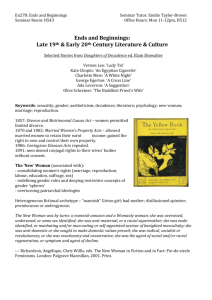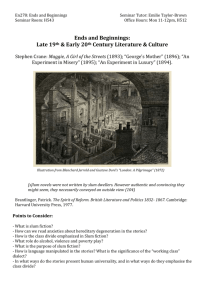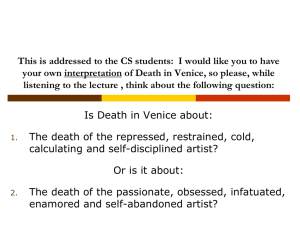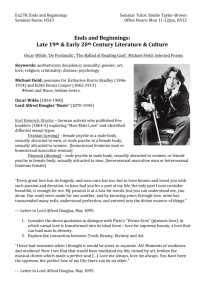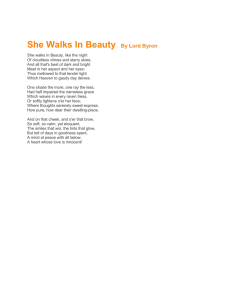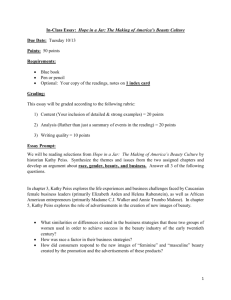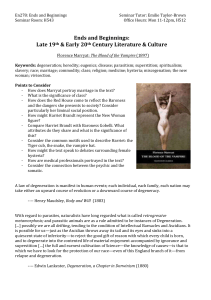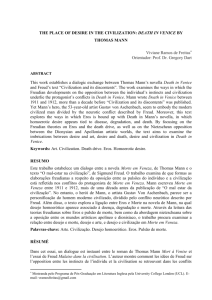Death in Venice
advertisement
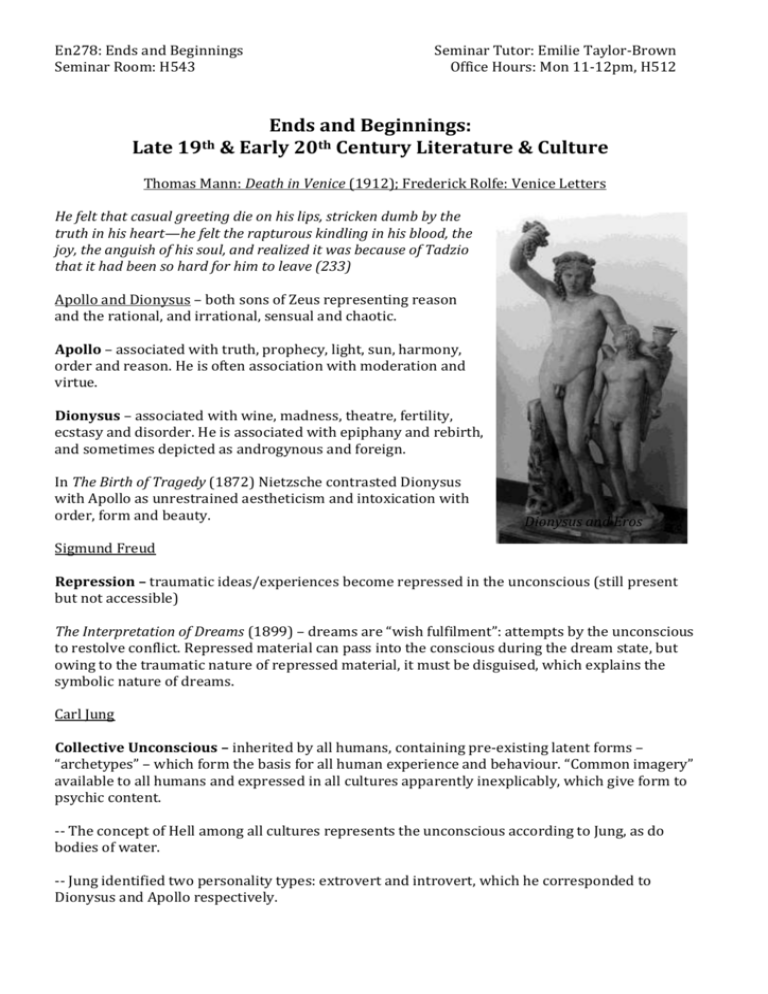
En278: Ends and Beginnings Seminar Room: H543 Seminar Tutor: Emilie Taylor-Brown Office Hours: Mon 11-12pm, H512 Ends and Beginnings: Late 19th & Early 20th Century Literature & Culture Thomas Mann: Death in Venice (1912); Frederick Rolfe: Venice Letters He felt that casual greeting die on his lips, stricken dumb by the truth in his heart—he felt the rapturous kindling in his blood, the joy, the anguish of his soul, and realized it was because of Tadzio that it had been so hard for him to leave (233) Apollo and Dionysus – both sons of Zeus representing reason and the rational, and irrational, sensual and chaotic. Apollo – associated with truth, prophecy, light, sun, harmony, order and reason. He is often association with moderation and virtue. Dionysus – associated with wine, madness, theatre, fertility, ecstasy and disorder. He is associated with epiphany and rebirth, and sometimes depicted as androgynous and foreign. In The Birth of Tragedy (1872) Nietzsche contrasted Dionysus with Apollo as unrestrained aestheticism and intoxication with order, form and beauty. Dionysus and Eros Sigmund Freud Repression – traumatic ideas/experiences become repressed in the unconscious (still present but not accessible) The Interpretation of Dreams (1899) – dreams are “wish fulfilment”: attempts by the unconscious to restolve conflict. Repressed material can pass into the conscious during the dream state, but owing to the traumatic nature of repressed material, it must be disguised, which explains the symbolic nature of dreams. Carl Jung Collective Unconscious – inherited by all humans, containing pre-existing latent forms – “archetypes” – which form the basis for all human experience and behaviour. “Common imagery” available to all humans and expressed in all cultures apparently inexplicably, which give form to psychic content. -- The concept of Hell among all cultures represents the unconscious according to Jung, as do bodies of water. -- Jung identified two personality types: extrovert and introvert, which he corresponded to Dionysus and Apollo respectively. En278: Ends and Beginnings Seminar Room: H543 Seminar Tutor: Emilie Taylor-Brown Office Hours: Mon 11-12pm, H512 The artistic reason for the misunderstanding lies in the difference between the Dionysian spirit of lyric poetry as it individualistically and responsibility pours itself out, and the Apolline spirit of epic narrative with its objective commitment and its moral responsibilities to society. What I was trying to achieve was equilibrium of sensuality and morality… Our fundamentally mistrustful, fundamentally pessimistic view of passion as such and in general … passion that drives to distraction and destroys dignity–that was really the subject matter of my tale. Greek Heroic Imagery Now day after day the god with the burning cheeks soared naked, driving his four fire-breathing steeds through the spaces of heaven, and now, too, his yellow-gold locks fluttered wide in the out-storming east wind. (234) Then indeed he would feel he had been snatched away now to the Elysian land, to the ends of the Earth, where lightest of living is granted to mortals, where no snow is nor winter, no storms and no rain down-streaming, but where Oceanus ever causes a gentle cooling breeze to ascend, and the days flow past in blessed idleness (235) 1. How and why does Mann use Greek mythological imagery to characterise the relationship between Aschenbach and Tadzio? 2. What effect does this characterisation have on the power-dynamics of the encounter? Venice as the Underworld Can there be any one who has not had to overcome a fleeting sense of dread, a secret shudder of uneasiness, in stepping for the first time, or after a long interval of years, into a Venetian gondola? How strange a vehicle it is, coming down unchanged from times of old romance, and so characteristically black, the way no other thing is black except a coffin–a vehicle evoking lawless adventures in the plashing stillness of night, and still more strongly evoking death itself, the bier, the dark obsequies, the last silent journey! (214) 3. Consider the characterisation of Venice as the Greek Underworld, its waterways as representations of the river Styx and its gondoliers as ferrymen. How might we interpret the narrative in light of this? Art, Divinity and Beauty Or he would be lying full length, his bathing suit wrapped around his chest, his finely chiselled arm propped on the sand, his hand cupping his chin; the boy they called ‘Jasiu’ would squat beside him caressing him, and nothing could be more the bewitching then the way the favoured Tadzio, smiling with his eyes and lips, you look up at this lesser servile mortal. (237) His armpits were still as smooth as those of a statue, the hollows of his knees glistened and their bluish veins made his body seem composed of some more translucent material…and yet you dear pure whale Will backpack here in Berkeley active, that had succeeded in Britain this the En278: Ends and Beginnings Seminar Room: H543 Seminar Tutor: Emilie Taylor-Brown Office Hours: Mon 11-12pm, H512 austere will that had here been darkly active, that had succeeded in bringing this divine sculptured shape to light–was it not well known and familiar to Aschenbach as an artist? (237) As his eyes embraced that noble figure at the blue waters edge, and in rising ecstasy he felt he was gazing on Beauty itself, or Form as a thought of God, on the one and pure affection that dwells in the spirit and of which human similitude and likeness has here even lightly and graciously set up for him to worship. Such was his emotional intoxication; and the ageing artist welcomed it unhesitating, even greedily. His mind was in labour, its store of culture was in ferment, his memory threw up thoughts from ancient tradition which he had been taught as a boy, but which had never yet come alive in his own fire. (237) For beauty, dear Phaedrus, only beauty is at one and the same time divinely desirable and visible: it is, mark well, the only form of the spiritual that we can receive with our senses and endure with our senses. For what would become of us if other divine things, if reason and virtue and truth were to appear to us sensuously? (238) For beauty, Phaedrus, Mark well! Only beauty is at one and the same time divine and visible, and so it is indeed the sensuous lovers path, Little Phaedrus, it is the artist’s path to the spirit. But do you believe, dear boy, that the man whose path to the spiritual passes through the senses can ever achieve wisdom and true manly dignity? Or do you think rather (I leave it to you to decide) that this is the path of dangerous charm, very much an errant and sinful path which must of necessity lead us astray.? For I must tell you that we artists cannot tread the path of beauty without Eros keeping company with us and appointing himself as our guide; yes though we may be heroes in our own fashion and disciplined warriors, yet we are like women, for it is passion that exalts us, and the longing of our soul must remain the longing of a lover–that is our joy and our shame. (265) 4. Consider the relationship between natural and artificial forms. How is Tadzio’s characterisation as a greek statue significant? 5. What is the relationship between Beauty, sensuality and divinity? 6. How does Eros restrict an artist’s access to the divine? Art and Sexuality Never had he felt the joy of the word more sweetly, never had he known so clearly that Eros dwells in language, as during those perilously precious hours in which, seated at his rough table under the awning, in full view of his idol and with the music of his voice in his ears, he shaped upon Tadzio’s beauty his brief essay (239) How strangely exhausted that labour! How mysterious this act of intercourse and begetting between a mind and a body! When Aschenbach put away his work and left the beach, he felt worn out, even broken, and his conscience seemed to be reproaching him as if after some kind of debauch. (240) 7. What is the relationship between Art and desire? 8. How does Mann align artistic production with sexual experience? 9. Is Art inseparable from Sexuality? En278: Ends and Beginnings Seminar Room: H543 Seminar Tutor: Emilie Taylor-Brown Office Hours: Mon 11-12pm, H512 Disease, Secrecy Immorality and the Unconscious Thus Aschenbach felt an obscure sense of satisfaction at what was going on in the dirty alleyways in Venice, cloaked in official secrecy–this guilty secret of the city, which emerged with his own innermost secret and which it was also so much in his own interests to protect. (246) This is Venice, the flattering and suspect beauty– this city, half fairy-tale and half tourist trap, in this insalubrious air the arts once rankly and voluptuously blossomed, where composers have been inspired to lulling tones of somniferous eroticism (248) He continued his undignified pursuit of him in the evenings along streets in which the disgusting mortal malady wound its underground way, then indeed monstrous things seemed full of promise to him, and the moral law no longer valid. (261) The harmful additional ingredient of this lagoon with its mephitic vapours (229) 10. How does the city function as a metaphor for the body and/or the mind? 11. In what ways is Venice intrinsically pathological? 12. What impact does the paralleling of disease and secrecy have on the narrative? And how are both of these related to morality? 13. How is Art presented as both “rank” and “blossoming”? Homosexuality and Purity “Then some great fat slow cow of a girl will just open herself wide, and lie quite still, and drain him dry. First, the rich bloom of him will go. Then he’ll get hard and hairy. And by july he’ll have a moustache, a hairy breast and […] be just the ordinary stevefore to be found by scores on the quays.” “And isn’t it true that the passionate boy must have an outlet for his passion; and, if he (preferring the male) can’t for whatever reason have what his nature prefers, doesn’t he almost automatically sink into the arms of a female and instantly become “man-like”. 14. How does pederasty complicate the performativity of gender? 15. Consider the association of homosexual adolescents with purity – the “safer sweeter way”, and the implications of this for the portrayal of women’s sexuality. 16. How are homosexual practices aligned with youth, asetheticism and beauty? En278: Ends and Beginnings Seminar Room: H543 Seminar Tutor: Emilie Taylor-Brown Office Hours: Mon 11-12pm, H512 Ancient Greece /classical imagery and “greek love” became coded phrase which enabled homosexual men of classical education to engage in taboo discourse. Also sanitizing effect. Dignity indignity Degradation “fall” Entwurdigung Order – disorder Relationship between Mann’s (1947) Doctor Faustus contracting syphilis as part of deal with devil, which drives him mad thereby enhancing his creativity and Death in Venice in which Aschenbach accepts the emotional intoxication of Tadzio and even risks death from Cholera in order to create art and indulge in sensuous pleasure. --based on true experience of Mann on holiday Kantian moralists align dignity with rational freedom of the will, which Aschenbach loses by his inability to do the rational and decent thing of warning the Polish family of the epidemic and leave Venice himself. The male artist in Mann’s work represents a converging of gender trouble with artistic production… identity as male and identity as an artist sees destined to confuse and contradict one another. (Webber, 70) --- old mans performance of youthful masculinity, accentuates his dissonance as a male subject ---- Freudian dream-narrative; gondolier drunken song/laughing song contagion of laughter and cholera, performance original wanderer figure and lip-smacking street singer; old masquerader on ship/aschenbach
